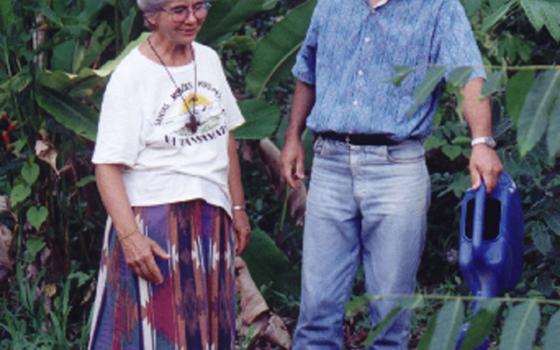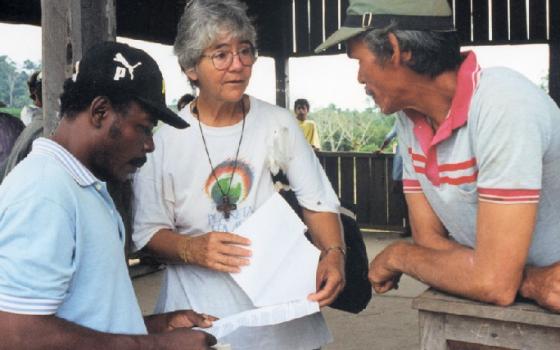In a simple wooden house on an unpaved street in the violent town of Anapu, near the heart of the Brazilian Amazon region, live two Catholic sisters who share pleasantries with neighbors and infuriate large landowners of the region.
Jane Dwyer, 78, and Kathryn "Katy" Webster, 66, both Sisters of Notre Dame de Namur, quietly help support poor agricultural workers in their struggles for land and better living conditions. The sisters continue the legacy of Sr. Dorothy Stang of the same congregation, who was murdered 14 years ago in rural Anapu.
In conversations among small circles of people, the area's powerful landowners blame the sisters and still accuse Stang of being responsible for the invasion of large properties by agricultural workers. "The big landowners think we are dangerous bandits for what we do," joked Dwyer. The only activity she and Webster engage in, Dwyer said, is to work with the Pastoral Land Commission (CPT), an arm of the Catholic Church that supports landless agricultural workers. Stang had also done so until she was killed at age 73.
"The people do not need us to decide what to do — they do it on their own,'' Dwyer said. "People only need a friendly presence," she added, explaining that missionaries never make decisions such as instigating land occupations. "The landowners like to blame us, but it was the people themselves who created the process of going to the government and saying 'there is an enormous piece of land that looks good and has no owner,' " Dwyer said. "When people occupied the land, we entered into the story. But we never encouraged them."
The sisters carry on their ministry against a complex social, economic and political backdrop in the region and the country. Tensions over land disputes are rising, evidenced by a rash of killings of agricultural workers involved in property claims. Thousands of workers drawn to the area by the Brazilian government's rapid construction of huge infrastructure projects, such as the nearby Bela Monte mega-dam, add to the land struggles. With the building boom waning, many now-unemployed workers strain the already-weak housing and sanitation services in Anapu.
The region is getting attention from the Vatican as well, with Pope Francis initiating a special Amazon synod in Rome Oct. 6-27 focusing on land use, biodiversity and rights of indigenous people.
The election of pro-development President Jair Bolsanaro presages more conflict. On the local level, landlords are turning to police, authorities and courts to fight back.
That's the case with Fr. Jose Amaro, who also worked with Stang. He recently defended himself in court against charges related to land occupation. After being threatened with death several times and jailed for three months, Amaro was released but forced to move to Altamira, about 80 kilometers (50 miles) from Anapu, as the case winds through Brazil's laborious legal system. His activities are restricted. He can celebrate mass, but cannot leave his residence between 8 p.m. and 6 a.m., must go to the courthouse and sign a "term of presence" every three months and cannot participate in any meetings or demonstrations involving land struggles or other public activities.
Violence in the region has escalated, with about 16 or 17 landless rural workers murdered in Anapu since 2015 in cases related to land disputes, according to the Pastoral Land Commission. Despite the assassinations, the sisters remain steadfast in their mission. "Fear does not apply to us," Webster said. "Everyone is living the same reality and we do not walk around thinking about it," she said. "We are simply living with the people."
This is the case also for Amaro, who "is being accused by the same groups that murdered Dorothy and who fear for our presence here," Dwyer said.
"The fact that Dorothy arrived to this region helped the people to stay," Webster said. "We're here today because of it." There were about 20 families living in the area where Stang was murdered in 2005, but now almost 300 families practice subsistence farming there.
"We remain here because we have a 'mouth out,' " Dwyer said, meaning that any violence against the sisters would immediately bring international repercussions. "If we leave, however, it will be a massacre a day and there will be no one to shout," she said. "We are all victims and threatened, but the biggest victims are the poor people," said Dwyer. "Taking them out of this land is death."
Dwyer obtained Brazilian citizenship in 2005, as did Stang about a year before she was killed. Stang's brutal murder sparked widespread outrage in the Anapu region, in Brazil, the U.S. and internationally. Her life and legacy have been immortalized in books, documentaries and an opera. A special study center — the Sr. Dorothy Stang Center for Social Justice and Community Engagement — was established at Notre Dame de Namur University in Belmont, California, in 2008.
But it is in the Anapu region, amid about 4,000 families of landless people and agricultural workers (a group of more than 15,000 people) that her legacy is most keenly felt — one that Dwyer, Webster, Amaro and others who worked with her — are determined to continue.
Dwyer arrived in Brazil in January 1972 during a military dictatorship and witnessed the brutality suffered by people living in extreme poverty. She went first to the state of Maranhão, then the city of Crateús in Ceará state in northeastern Brazil, an area persecuted by the army, she said. People were often imprisoned and tortured. Friends disappeared. It was hard to tell who to trust.
A region of severe drought, she remembers the harsh conditions people endured, walking miles for water. "That was not life nor a job," she said. "That was torture and slavery."
Yet communities of Catholics and evangelicals used Bible study to bolster the courage of local people. The people had the "capacity of going to the streets and fight for freedom to organize and meet in the evenings," Dwyer said. She recalls them having "the courage to face guns to make democracy be born and the happiness when it really started to happen,"
After two decades of military rule, Brazil began a bumpy transition to democracy in the 1980s with local and national elections. The people who organized and worked to bring about Brazil's democracy gave her hope, Dwyer said. "We lived the uprising of a Brazil that was hidden," she said. "I'd fallen in love with the people and for that Brazil that was being born, and who had a different way of living in the countryside."
In 1997, Webster moved to Para State (where Anapu is located) to join Stang, first in Altamira, then to Anapu. She also lived and worked for four years with the CPT in another violent Para state city, called Itaituba (388 miles - 625 kilometers - from Anapu) and went definitively to Anapu in 2006. "My motivation to come to Anapu was to share the journey of Dorothy and the people in this region," Webster said. "I stayed because I was captivated by the people in their struggle and by the nature I met here."
Implementation of a land reform system known as the Sustainable Development Projects (PDS) began in the early 2000s. The idea was to ally agrarian reform, one of the biggest social problems in the country, to the maintenance of the Amazon rainforest. Under this system, formerly landless workers occupied tracts of uncultivated land and then petitioned the national government to combine the management of forest and food products, such as wood and the açaí fruit, in 80 percent of the area where the forest remains. The other 20 percent is for the individual use of each family.
About 300 families live and farm in the original PDS Hope, a total area of about 37,000 acres, where Stang was killed. Two years ago, the national government suspended the process of distributing land there for reasons that are unclear.
Yet the process of land settlement and re-distribution continues. Essentially, settlers identify areas declared available to be distributed under the agrarian reform process in other areas outside the PDS and occupy them in a defacto strategy to force the state to move ahead with the formal process of distributing property titles and start supplying services such as sanitation, transportation, schools and healthcare.
This designation of public lands for landless workers makes large landowners angry because they don't want these areas to be distributed as part of agrarian reform. According to Dwyer, the large landowners are also involved with the theft of huge portions of land from both the state and agricultural workers in a process known in Brazil as "grilagem." They occupy the land with private armed militias, bribe public employees and create fraudulent property titles.
"Associated with grilagem there is a whole package of crimes that involves illegal removal of noble woods from the forest, car theft, money laundering and other crimes common in the Amazon. It is this whole package that explains the murder of Dorothy," she said.
"Why do we stay? Because we know that there's an alternative," Dwyer said. "The people entered decisively into the struggle and believe that these lands belong to them because they have the right. They make their living exploring the land but not destroying the forest and if they destroy, they replant it and don't privatize the waters."
The occupations by agricultural workers are decided in independent meetings, without the participation of the sisters. The sisters only support the occupations after they are installed, with public expressions of solidarity through connections with press and the church.
Their determination to stay doesn't change, even when the sisters speak of extreme-right former army captain Bolsonaro, who assumed the presidency of Brazil on Jan. 1.
Bolsonaro, dubbed "Trump of the Tropics" in some media because his harsh rhetoric and tough policies align with U.S. President Donald Trump, signals difficult times, but not enough to make them give up their missionary work. In a visit to the U.S. in March, Bolsonaro said he told Trump of his willingness to "open to (Trump) the exploitation of the Amazon region," according to an interview on radio station Joven Pan in April. Bolsonaro also complained that land set aside for reserves for indigenous people hampers development.
Bolsonaro promised to "open" indigenous lands in the Amazon region to international economic projects of all kinds — a possibility that threatens environmentalists. Currently, Brazil's Congress has to give specific permissions to the development of each project.
Given Bolsonaro's positions, "the situation is horrifying and frightening — but that's the way it is," Webster said. "This is our life to be here."
Land disputes are now more complicated by pressures brought by rapid construction of huge infrastructure projects, displacing thousands of people while drawing others as workers for specific projects. Between 2003 and 2016, the rapid building of enormous highways, mega-dams, mining facilities and other projects throughout Brazil has impacted heavily indigenous peoples, rural workers and families living in isolation along rivers. One of the biggest was the Belo Monte Dam, located halfway between Altamira and Anapu.
While the impact was greater in the larger city of Altamira, a number of workers have started demanding land distributed by agrarian reform projects near Anapu. One, called Mata Preta, one of the most recently legalized agrarian reform areas, received a dozens of former Belo Monte workers.
An estimated 3,000 former workers have moved to Anapu in recent years, putting even more pressure over public services – especially healthcare and security. IBGE, Brazil´s official statistics agency, estimates that between 2010 and 2018, during the construction of Belo Monte, Anapu's population increased 30 percent to 27,000 people compared with 12 percent in the state of Para and 6.5 percent in Brazil overall. Today, only 6.1 percent of the city's population is employed in the formal labor market
Webster notes that Anapu is not recognized by the authorities or the company responsible for the construction of Belo Monte as an area impacted by the building of the megadam. "But in fact we are very impacted," she said. "Near the Xingu River are many camped workers, who are still working on the construction of the power transmission system. They will have no more work and nowhere to live after the construction ends," she added.
Global Sisters Report tried several times to contact Anapu's mayor, Aelton Fonseca, but he didn´t respond to requests for an interview.
Even facing an increasingly violent atmosphere, Dwyer, Webster and Amaro continue Stang's work by choosing to stay with the landless agricultural workers. They live and work in one of the most violent regions of the world, where the Brazilian state is scarcely present and murders and even collective massacres are frequent.
One stark example occurred March 13 when a rural worker known as Magalhães, a farmer almost 90 years old, was shot five times in the head. To date, no one has been charged. Magalhães had been involved in land disputes and there was nothing taken from his home, noted local workers who lived close to him and asked not to be quoted by name.
Unfortunately, this is not unusual in Anapu. With 31 people murdered in the city and rural area in 2016, the last year surveyed, the area has a murder rate double that of the surrounding state of Para, and three times that of Brazil, according to the Atlas of Violence in Brazil, edited by official agencies.
So great is the wave of violence that the annual Pilgrimage of the Forest, a 25-kilometer march in the rural areas of Anapu by religious leaders and landless farmers usually held every June since Stang's death, last year took place in the center of the city because the workers feared more deaths if they ventured to the outskirts.They shouted "Stang lives!" and added "Father Amaro lives" in support of the priest who at that time was temporarily incarcerated. This year, the Pilgrimage of the Forest will be held in July.
An example of Stang's legacy is the Anapu Defense Committee (CDA), which local farm workers created after her death and meets regularly. The group demands from the local government an improvement in living conditions such as housing, sanitation and schools. "Almost every month since her death we gather dozens of people at CDA," observes Francisco Pereira de Melo, farmer and professor at a community school in Anapu settlements, who also worked with Stang. "We never lost the organization," he said.
The CDA meetings take place at the Sao Rafael Training Center, a huge wooded area in the center of Anapu, that belongs to the Catholic Church. In the gardens of this center, in the sight of every visitor, is Stang's grave.
The CDA gatherings are probably the main legacy of Stang's struggle, say both sisters. But there are others. It is also at Sao Rafael where people of all faiths get together, including Catholics and Neo-Pentecostals, whose leaders in the Brazilian Congress usually ally with deputies and senators who represent large landowners.
People get together independently of their faith, the sisters said. "On a daily basis, there is no separation between Catholics and Evangelicals," Dwyer said. "When you want to pray, you go where you feel most at home. But in practice, the religion of this people is the land, because whoever has a piece of land does not go hungry any more. They may have no education nor health but they don't starve anymore."
"Dorothy's arrival helped the people to stay in their lands, and everything we still have here is due to the fact that there are people living here where a very few people lived before," Dwyer said. "She helped people to start a long journey."
[Carlos Tautz is a journalist based in Rio de Janeiro. He mostly writes about human rights, international issues and economy.]





